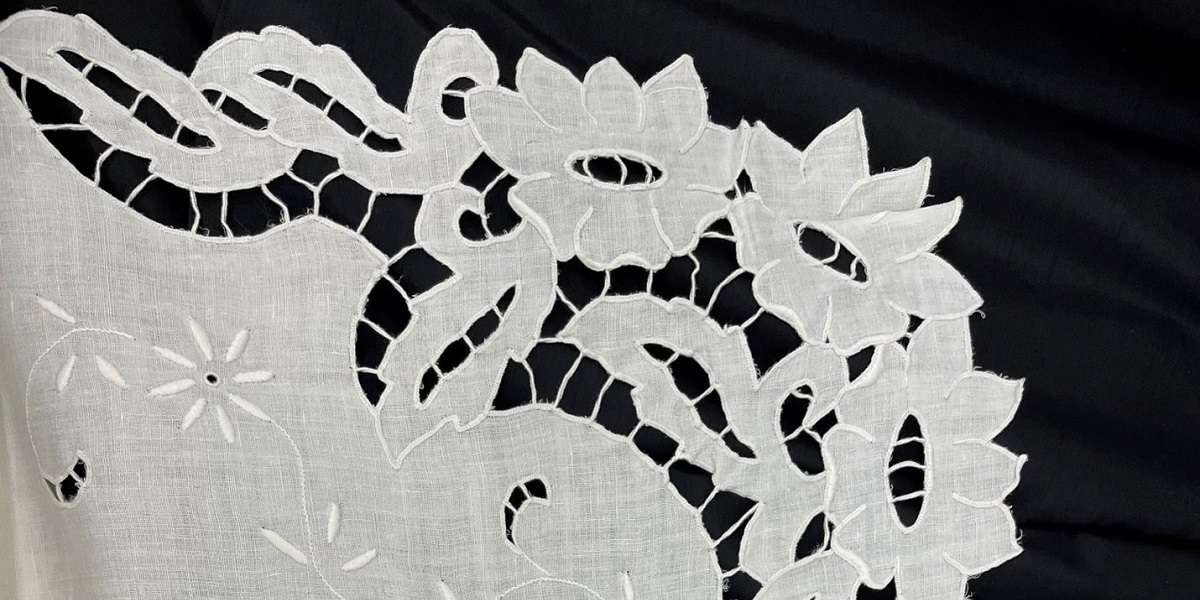Mme Corbière's Cutwork
March 1, 2024
By Julia Petrov, Curator, Daily Life and Leisure
In 1907, nine enterprising French-Canadians – among them, 45-year-old Wilfrid Ouimet – settled in the Moose Lake area. Their community was named Bonnyville, after their priest, and the town quickly grew to include a post office, church, store, and school.
Once a cabin had been built, Ouimet brought his wife, Ernestine (née Dagenais) and their children from where they were staying in the French-Canadian hamlet of Beaumont. A photo of the family is held by the Provincial Archives of Alberta:
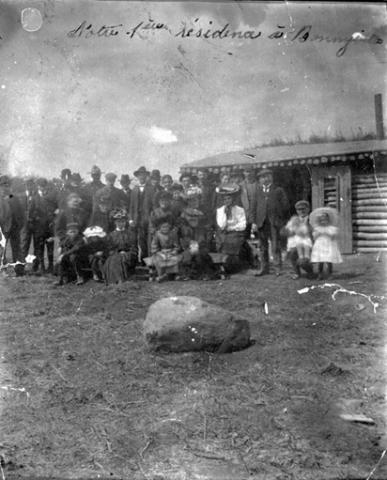
William Ouimet and Family's Arrival to Bonnyville, Alberta, May 1907, Provincial Archives of Alberta
The family became part of a wider network of Francophone settlers in the region. One of Wilfrid’s daughters (born on June 14, 1900, in Ste. Rose, QB) was named Amandine; she is probably one of the little girls on the right of the photograph, above. Girls then were expected to be proficient needlewomen, and Amandine was taught to embroider by the wife of the town’s first doctor, Mme. Sabourin, around 1917. She spent the next years preparing a trousseau, including church and household linens like tablecloths, bedspreads, and napkins for her future married life. She recalled purchasing embroidery transfer patterns from the Montreal department store Dupuis Frères mail-order catalogue, launched in 1921. Although Amandine did the embroidery herself, she would sometimes send her works to Edmonton to be hemmed professionally. Working in the evening beside a kerosene lamp, or on Sunday afternoons, Amandine used cotton thread to create her designs, later pressing the finished pieces on the wrong side over a flannel sheet to puff up the embroidery.
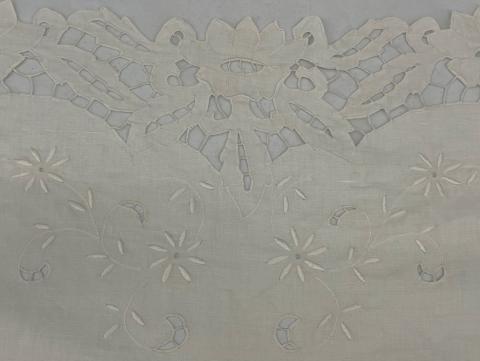
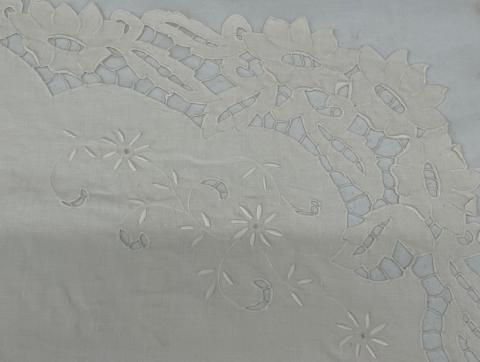
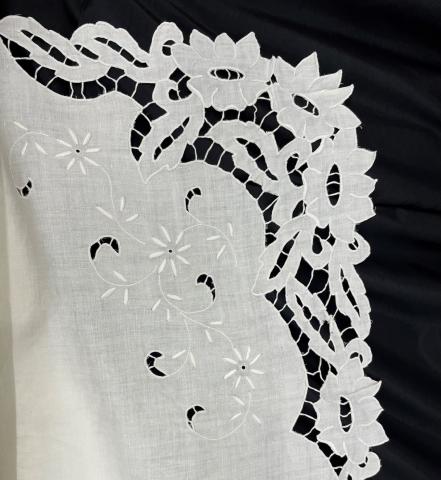
Linen tablecloth, embroidered by Amandine Corbière, 1917-1930, Royal Alberta Museum
Amandine married another local Francophone, M. Paul Corbière, and settled in Mallaig, a hamlet about 50km east of Bonnyville. While some of the pieces (such as the tablecloth illustrated here) were used in her home during her life, most of the linens she had so carefully prepared were not wanted by her descendants. She sold them in 1978, and they were donated to the Royal Alberta Museum in 1981.
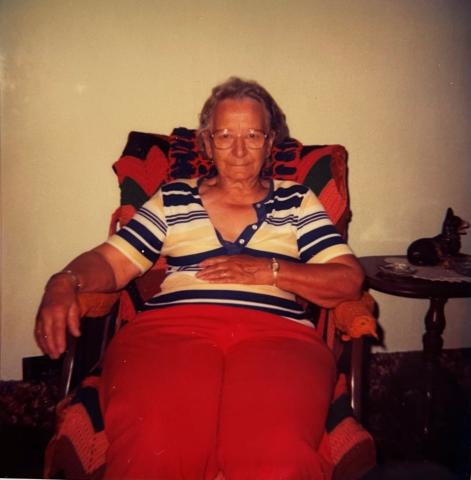
Amandine Corbière in 1981, Royal Alberta Museum
Most of the textiles held by the RAM are done in a type of cutwork embroidery called Richelieu-style. A design is drawn or transferred onto white or beige fabric (usually cotton or linen), then covered with buttonhole stitch. The space inside the embroidery pattern is carefully cut away, creating a lace effect. Indeed, cutwork embroidery is the ancestor of modern lace, which, in the 16th century, began to be created either by sewing together layers of threads with a needle, or braiding them together with threads wound on bobbins. While Armand Jean du Plessis, Cardinal Richelieu (1585 –1642), lived in a period when lace was very fashionable, there are no images of him wearing cutwork embroidery of this type.
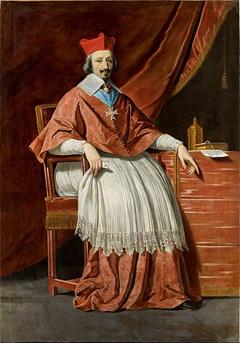
After Philippe de Champagne, Portrait of Armand Jean du Plessis de Richelieu, 1636, oil on canvas, Musée Condé, Chantilly
However, the Cardinal is attributed with the invention of the table knife, around 1637, with its blunted end meant to prevent diners from picking their teeth with the points of their knives. Given that most of Mme. Corbière’s linens are cutwork tablecloths, this seems an appropriate link!
If you would like to try your hand at creating some cutwork linens, I have found a clipping of a period pattern with similar motifs to the tablecloth created by Mme. Corbière in our files. Click on the image for a high-resolution image to print at full size. Although the suggested use is a collar, the design could also be used to edge a table runner, napkin, tablecloth corner, or tea towel. If you use this pattern, tag the museum in a photo of your creation on social media!
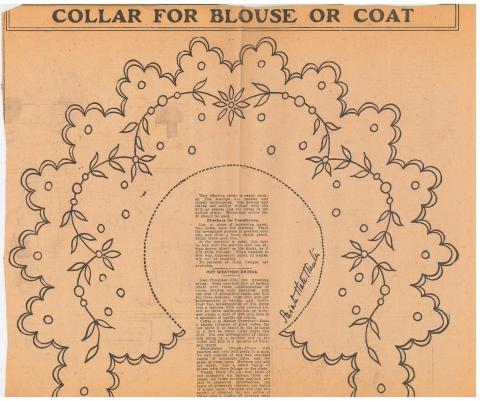
Sarah Hale Hunter, embroidery pattern, probably published in the Winnipeg Free Press c. 1913; clipping in the collection of the Royal Alberta Museum.
